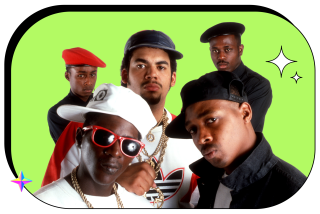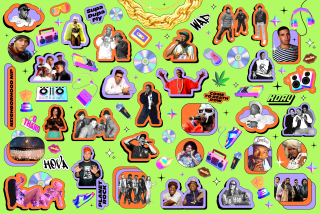Plug ‘Em In, Watch ‘Em Go
“This is dangerous,” one of Prodigy’s two frontmen, MC Maxim Reality, declared during the English dance-rock band’s manic performance Wednesday at the Mayan Theatre. “Open up your head, feel the shell shock.”
They were the opening lines to “Mindfields,” one of the songs on the long-awaited new Prodigy album that is due July 1 from Maverick Records--and the lines define nicely the role of this band in trying to open up the ways we think about pop music.
By mixing synthesizer-driven instrumentation and the party-minded spirit of the dance world with the rebellious attitudes and themes of rock, Prodigy serves as a bridge between those two worlds.
Despite all the debate whether the dance and rock cultures can be compatible, the frequently thrilling 70-minute concert underscored a basic pop rule, one that was true in the ‘50s, when rock was born, and remains true in the ‘90s, when its relevance is being questioned.
There may be endless genres of pop, from grunge and neo-punk to industrial and dance, but ultimately there are only two kinds of music: good and bad.
Prodigy is good--very good.
Whatever its ultimate effect on commercial pop, the biracial group is an invigorating, purposeful outfit that offers the same kind of liberating assault on the musical and cultural status quo that the best rock acts have done over the years.
Though rock groups from Kraft-werk to Depeche Mode have succeeded commercially while relying largely on synthesizers, dance music has generally been rejected by mainstream rock fans because the musicians tend to be faceless (often hiding behind banks of electronic equipment a la the Chemical Brothers) and the music itself is often devoid of accessible melodies and themes.
That’s not the case with Prodigy. This is a band with a strong sense of personality and commentary.
Keith Flint is a singer and dancer who is destined to go down as one of rock ‘n’ roll’s true characters--a ‘90s version of Johnny Rotten, with pierced ears, nose and tongue, and red and purple scarecrow hair that looks as if it were parted by a lawn mower.
More than simply a striking image who took over vocally from MC Maxim Reality on a few songs, however, Flint represented the ultimate dance club fan as he bounded about gleefully and climbed into the audience to touch his mates. He worked so hard it was understandable that he took turns in the spotlight with a second dancer, Leeroy Thornhill.
*
But the heart of the band is Liam Howlett, who created the music as he moved actively among a battery of synthesizers at the rear of the stage, creating complex beats and teasingly seductive breaks.
There were times early in the set when the dancing seemed a bit too choreographed and moments when Howlett’s music came across as more sonic salad than a fully satisfying meal.
But those drawbacks faded once Prodigy began kicking in with its most commanding numbers, including the anthem-like “Fire-starter,” whose video is so striking that it helped convince MTV to expand its programming to dance acts, and “Serial Thrilla,” a song from the upcoming “The Fat of the Land” album that rivals “Fire-starter’s” emotional rush.
Howlett sometimes supplemented his electronic soundscapes with a guitarist, but his sound was often so hard to discern in the musical roar that the instrument’s presence on stage seemed little more than a symbolic nod to the combat-rock influence of the Clash.
But the Clash connection is important.
By weaving together the politics of punk, the celebration of hip-hop, the informality of ska and the futuristic pulse of dance music, this band aims--like the Clash--to deliver a sense of self-affirmation and generational identity. But the lyrics--sketchier than those in most rock songs--are never allowed to distract from the energy of the music.
In “Mindfields,” another stand-out in the show, the “dangerous” reference is aimed to outsiders--a warning that there is a new generation echoing a battle cry in rock that stretches from the Who to Rage Against the Machine.
More to Read
The biggest entertainment stories
Get our big stories about Hollywood, film, television, music, arts, culture and more right in your inbox as soon as they publish.
You may occasionally receive promotional content from the Los Angeles Times.










